1) The 210-hp (with ram-air effect) Kawasaki Ninja H2 is fast, and it feels very fast. But it felt less so once I climbed back onto the bike following three back-to-back sessions aboard its track-only 326-horse H2R stablemate. It's all relative, I guess. At this point, I have ridden this pair of supercharged sportbikes only on a sweeping MotoGP circuit. I shudder when imagining just how insanely quick the street-legal Ninja H2 will feel on public roads.
2) With a claimed curb weight of 525 lb., the H2 expectedly lacks the agility of the Ninja ZX-10R. But ridden with smooth and precise steering input, it negotiated the 3.375-mile, 16-turn Losail circuit with surprising competence. The H2R, which weighs 49 lb. less, offers a notable improvement in handling agility and overall stability, along with improved feedback and less fore-aft weight transfer. Both H2s fill the handling middle ground between Kawasaki's ZX-10R and ZX-14R models.
3) The Bridgestone Battlax V01 race slick radial tires put the cornering clearance of the H2 and H2R to the test. I tend to lean bikes pretty deep and I frequently ground the H2's peg feelers, while the shift-lever tang and trailing edge of the sidestand also occasionally touched down. The H2R never skimmed its sidestand; nor did either bike grind its exhaust. For machines in this weight class, these Kawasakis have impressive bank-angle potential.
4) Aboard the H2R, I hit an indicated 203 mph on Losail's main straight prior to my braking marker for turn one. It was still pulling strong in top gear with about 1,500 revs to spare. I can't tell you precisely how much rpm remained because my focus, naturally, was well up the road at that moment of each lap. While our POV video offers a clue of just how fast the H2R is, the tank-mounted camera didn't allow for a full tuck to replicate my fastest runs up the straight. And let it be known that I fully appreciated the stopping power and consistency of the H2R's brakes, which feature 330mm front rotors and cast aluminum Brembo monobloc calipers.
5) Hotshots who feel they don't need no stinkin' electronics may experience a rude awakening with either of these supercharged Ninjas. Both employ KTRC (Kawasaki Traction Control), which offers nine levels of adjustment and an off position. While I look forward to straight-line testing these H2s in the raw with TC turned off, patience is a virtue when hot lapping this road course in the Persian Gulf. Even at lower KTRC settings (less intervention) it doesn't take much throttle to trigger the system while cornering. The flickering yellow TC indicator light on the dash may as well read: "Highside Avoidance Enabled."
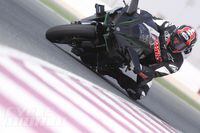
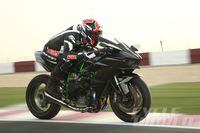
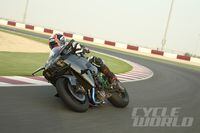
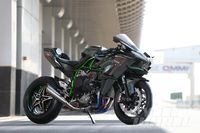
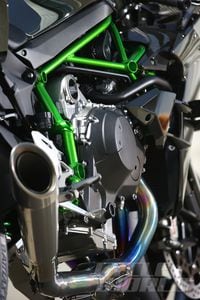
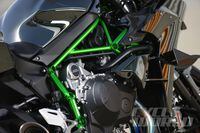
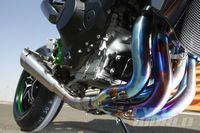
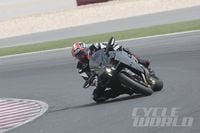
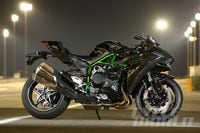
/cloudfront-us-east-1.images.arcpublishing.com/octane/BW43XOMS5RA2RB5QLEXD4NTNYE.jpg)
/cloudfront-us-east-1.images.arcpublishing.com/octane/GMG6KKHK4ZDLBFILW6L5UHJC4M.jpg)
/cloudfront-us-east-1.images.arcpublishing.com/octane/6BQBLTD22JHEFH2OBE5ZGY74NU.jpg)
/cloudfront-us-east-1.images.arcpublishing.com/octane/OVNMRSCISBB2FG4GQLQAYN56MU.JPG)
/cloudfront-us-east-1.images.arcpublishing.com/octane/7KSW4EGJWBGKFA62G4OARG7POU.jpg)
/cloudfront-us-east-1.images.arcpublishing.com/octane/OX5X6DCDXRBHBDLSLR2PRRJMSE.jpg)
/cloudfront-us-east-1.images.arcpublishing.com/octane/4FN63Z3XEVBMBDP3W6GFPLICRU.jpg)
/cloudfront-us-east-1.images.arcpublishing.com/octane/2CYHINRF5RA7VBO3PRJPVU5IBE.jpg)
/cloudfront-us-east-1.images.arcpublishing.com/octane/X7JX7MGA5ZBCDGDVAA2LKUGCTQ.jpg)
/cloudfront-us-east-1.images.arcpublishing.com/octane/7TO4TMPM6JBJJPBWUMT35TJHHA.jpg)
/cloudfront-us-east-1.images.arcpublishing.com/octane/3CANJMY47BH6BNPDAODAUD3CWQ.jpg)
/cloudfront-us-east-1.images.arcpublishing.com/octane/4IGJJZ6HWNAIHJ343U7CUH4WC4.jpg)
/cloudfront-us-east-1.images.arcpublishing.com/octane/BP5NOY5NPVGOZIDU5FN7M42JMA.jpg)
/cloudfront-us-east-1.images.arcpublishing.com/octane/XH2ETEU4NVGDFNQO2XT2QQS5LU.jpg)
/cloudfront-us-east-1.images.arcpublishing.com/octane/TGJNNI474VFXFMS3YQDRIEKEFY.jpg)
/cloudfront-us-east-1.images.arcpublishing.com/octane/5QAQVX645VA3LKJFZ3C4Y2DTPI.jpg)
/cloudfront-us-east-1.images.arcpublishing.com/octane/45O2MZU525ATPB5GRG422ZTU54.jpg)
/cloudfront-us-east-1.images.arcpublishing.com/octane/WEWXDN2F2BD3DJYUJJX4RZIALA.jpg)
/cloudfront-us-east-1.images.arcpublishing.com/octane/VPDWRXQWRVGULBY7Z3JRGPTR2I.jpg)
/cloudfront-us-east-1.images.arcpublishing.com/octane/56QNDMMUA5EA3OCJINPCI2QZGA.jpg)
/cloudfront-us-east-1.images.arcpublishing.com/octane/BHOJALDF55CPXGFWVLVKBPYZZI.jpg)
/cloudfront-us-east-1.images.arcpublishing.com/octane/BRQMHRCC4FH5HK4D3HUMG6XEKM.jpg)
/cloudfront-us-east-1.images.arcpublishing.com/octane/2CPX3CKQZFFT5H2ISBRTCIAUPY.jpg)
/cloudfront-us-east-1.images.arcpublishing.com/octane/W6JSA4VWCFFDDAAN3AAWO6ZTPE.jpg)